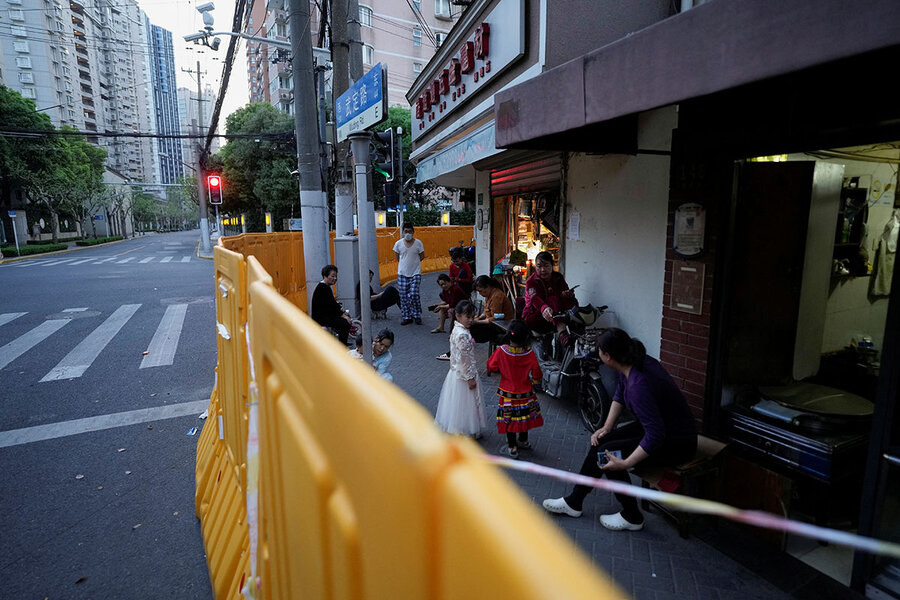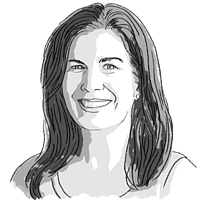‘Like a Kafka novel’: Witnessing China’s zero-COVID policy
Loading...
| Shanghai
I had just landed in the epicenter of China’s worst coronavirus outbreak in years. At the airport in Shanghai, an army of pandemic enforcers – workers covered head to toe in white protective vests, face shields, and gloves – swarmed the incoming travelers from my March 17 flight. It was the beginning of a weekslong saga of strict quarantines, police questioning, and bureaucratic chaos.
The unparalleled scale and extremes of China’s pandemic controls in Shanghai – which, for instance, have required me to undergo 17 COVID-19 tests in just over four weeks – show vividly how China’s top-down political system and the cost-benefit calculations made by a few are upending the lives of millions of ordinary Chinese people.
Why We Wrote This
An insider’s view of the Shanghai lockdown offers insight into China’s aggressive COVID-19 control measures, and the moral and political questions they raise.
Chinese leader Xi Jinping has put his personal stamp on the zero-COVID-19 policy, hailing its successes as proof of the superiority of the country’s Communist Party-led political system. The approach has been credited with achieving a low level of cases and deaths compared with many other countries. But as cases rise, the rigid anti-COVID-19 strategy is exacting an ever greater social and economic toll.
As the rest of the world moves away from lockdowns and other strict measures, China risks becoming stuck in cycles of costly lockdowns that wear residents thin, as I discovered in Shanghai.
“You should go home,” warned the restaurant owner, pointing to a surveillance device posted above us on the street. “There’s a lockdown and cameras are everywhere!”
I turned back onto the deserted Shanghai sidewalk and moved on. It was April 1, and I was on my first foray outside my hotel room under China’s zero-COVID-19 regime. After 14 days quarantined in a room with an alarm that sounded whenever I opened the door, I might have been forgiven for enjoying a breath of fresh air. In fact, I was on a mission: to secure food.
Two weeks earlier, I had landed in Shanghai with my husband just as the city of 25 million people was emerging as an epicenter in China’s worst coronavirus outbreak since the pandemic began in Wuhan in late 2019. I had waited for three years for the China visa I needed to take up my post as the Monitor’s Beijing bureau chief, and Shanghai was the required port of entry.
Why We Wrote This
An insider’s view of the Shanghai lockdown offers insight into China’s aggressive COVID-19 control measures, and the moral and political questions they raise.
At the airport, an army of pandemic enforcers – workers covered head to toe in white protective vests, face shields, and gloves – swarmed the incoming travelers from my flight. In much the same way, the strictly controlled, techno-bureaucratic system I’d landed in closed its grip, dominating my daily existence in a way I’d never imagined.
The unparalleled scale and extremes of China’s pandemic controls in Shanghai – which, for instance, have required me to undergo 17 COVID-19 tests in just over four weeks – show vividly how China’s top-down political system and the cost-benefit calculations made by a few are upending the lives of millions of ordinary Chinese people.
Chinese leader Xi Jinping has put his personal stamp on the zero-COVID-19 policy, hailing its successes as proof of the superiority of the country’s Communist Party-led political system compared with those of other nations. From Mr. Xi on down, party officials know their careers depend on stamping out – or better yet, preventing – serious outbreaks.
To be sure, China’s draconian approach has been credited with achieving a low level of cases and deaths compared with many other countries. But as cases rise, the rigid anti-COVID-19 strategy is exacting an ever greater social and economic toll. All but 13 of China’s top 100 cities, which together account for 70% of gross domestic product, have now imposed some quarantine restrictions.
As the rest of the world moves away from lockdowns and other strict measures, China risks becoming stuck in cycles of costly lockdowns that wear residents thin, as I discovered in Shanghai.
Stuck inside
Searching for food felt surreal in the upscale but empty Shanghai neighborhood, with its yoga studio, posh eateries, and coffee shops. Amid shelves depleted from panic-buying, I found some milk, tuna, and crackers and hurried back to the hotel.
The next morning, the hotel told all guests to stay inside. Fresh out of quarantine, I was locked down again, this time along with the rest of Shanghai.
Glued to my window, I watched quarantine enforcers – nicknamed da bai, or “big white” – begin shouting through megaphones at a nearby intersection.
As it turned out, they were summoning residents for testing, carrying out an extraordinary order by Shanghai authorities to test the whole city in a single day. China’s zero-COVID-19 playbook is essentially this: Test everyone; quarantine positive cases and close contacts in hospitals or huge, makeshift shelters known as fang cang; and repeat until case numbers return to zero.
Individuals are linked to this regime through a digital health code on their phones that tracks their test results, locations, and even whether they’ve bought medicines related to COVID-19. It automatically assigns them a green, yellow, or red risk status that determines whether they can move around, are restricted at home, or are quarantined.
Complicating matters, how to obtain and keep the coveted green status can be opaque. Each city has its own system, and data is shared with police.
“This is like a Kafka novel!” exclaimed one traveler on the WeChat instant messaging group I’d joined of mostly Chinese people from my flight. We were all headed to Beijing, known for its extra-strict entry rules.
“The slightest mistake, and the whole game is lost,” said another.
Although strangers, we traded tips and cheered each other on, gaining some comfort in our solidarity.
Eroding trust
Faint at first, the unmistakable sound of screaming broke the night quiet. I pushed open the window. From apartments scattered across Shanghai’s high-rise horizon, people were crying out their frustrations en masse.
After weeks of denying a lockdown was imminent, Shanghai officials imposed it overnight – giving residents virtually no time to prepare. Despite nightly news coverage showing truckloads of vegetables arriving in the city, food and medicine shortages took hold because people were not allowed to go to the store, food delivery services were overwhelmed, and government distribution plans failed at “the last 100 meters,” officials admitted.
Tragedies soon followed. With hospitals prioritizing COVID-19 patients, people with other illnesses began to perish. One Shanghai nurse died after her own hospital refused to admit her. Shanghai has not reported any COVID-19 deaths during the latest outbreak.
“You can starve, but you can’t die from COVID,” said one Shanghai netizen, joining an outpouring of online complaints.
Anger surged over conditions in the cavernous quarantine facilities – one with 40,000 beds – and a policy, later adjusted, to separate parents from children.
As sporadic anti-lockdown protests broke out, the Shanghai Communist Party committee issued an open letter urging all party members to “dare to show their swords” and speak out against “rumors.” But many online comments suggest a lack of confidence in local leaders.
“Will there be a future for a Shanghai government that the masses are not willing to trust?” asked one person who claimed to be a party member.
Meanwhile, Beijing authorities ordered Shanghai to double down on its approach and sent in 2,000 medical personnel from the military and 30,000 more from the provinces.
Our Shanghai escape
On Friday, as the U.S. State Department warned U.S. citizens not to travel to Shanghai, my husband and I got the last-minute test results and precious green codes required to board a train to Beijing.
As the high-speed train accelerated out of the city, zipping north past green fields into the province of Jiangsu, I exchanged celebratory messages over the escape with others in my Beijing-bound WeChat group. But the elation was short-lived.
Changing trains in Nanjing, passengers from Shanghai were surrounded by scores of police in personal protective equipment who seized our ID cards and passports and herded us into crowded lines for a chaotic, hourslong “registration” process. Arguing and yelling at one another, the police lacked clear direction and gave none to us. After forcing us and many others to miss connecting trains, they began to quarantine the stranded travelers from Shanghai.
The Nanjing dragnet showed how desperate other provinces are to prevent the Shanghai outbreak from spilling onto their turf.
I managed to get our passports back and used a phone app to buy new northbound tickets. Over the next 24 hours, we were detained twice more. In the northern Jiangsu city of Xuzhou, quarantine workers held us overnight in a fenced area outside the station, where we slept on the sidewalk. The next day we made it to Beijing, but by then our Beijing green codes had turned yellow, so we were detained again for several hours by police at the Beijing station. A helpful Foreign Ministry official secured our release to a hotel, for another 14-day quarantine.
Almost immediately, our phones started ringing with dozens of calls from Nanjing, Xuzhou, Tianjin, and Beijing – all the cities we had passed through after leaving Shanghai. Word arrived that we may have been exposed to a positive COVID-19 case, and could be taken to a centralized quarantine facility.
In China today, that inadvertent exposure, call from police, and involuntary quarantine could come at any time. But after yet another negative COVID-19 test, we have been given permission to stay in the hotel.










